DOWNRIGGERS FISHING ABOVE THEIR WEIGHT
■ Words & Images by Grant Dixon
Downriggers are one of the most versatile but underutilised bits of kit available to recreational fishers.
I recall the hue and cry when the use of downriggers was trialled prior to their introduction into the Taupo fishery. The old school brigade was heralding them as the demise of the fishery, but history has shown this not to be the case.
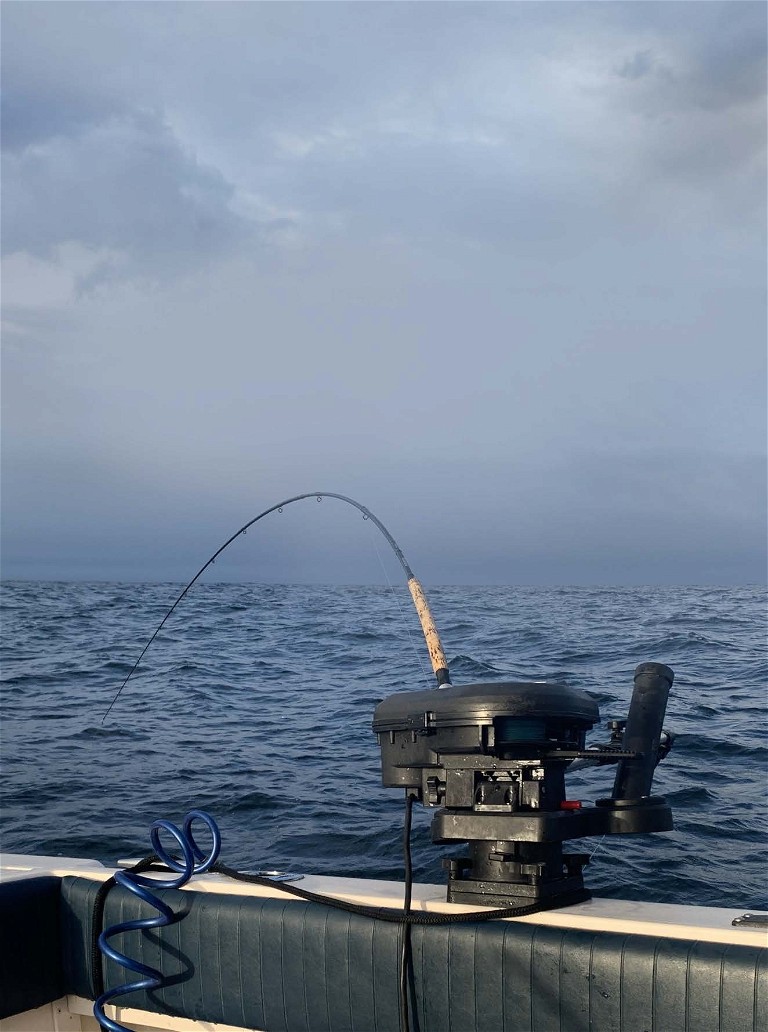
When trolling, downriggers can be used to fish a wide range of depths from just a metre or two under the surface down to 30 metres plus.
Prior to their introduction, anglers were dragging 100 metres plus of wire or 10 colours plus of leadcore line to get down to the deeper fish, hardly the most sporting way of catching the noble trout! Today those same depths can be fished using 4kg mono which enables the quarry to put up some semblance of a scrap. Trout trollers no longer needed to carry an arsenal of rods – wire, lead and harling outfits x 2 or 3 – as a couple or three specialist downrigging rods and reels and you have all the bases covered. For this angler, it has revolutionised trout trolling for the better, allowing me to run lures at harling through to deep trolling depths with the same set of lighter gear.
There are a couple of things skippers running downriggers need to be aware of. Firstly, you need to get it right when adjusting the ball depth in relation to the bottom. This means using the ‘rigger’s line counter in conjunction with the sounder to avoid snagging. Pay attention to the sounder, noting any depth/bottom terrain changes. When fishing unfamiliar territory, I will regularly call the depth so the anglers can make the necessary adjustments, involving everyone in the process.
A technique I have used in places where there is a consistent sandy bottom is to allow the ball to lightly touch down, stirring up the occasional ‘dust’ cloud. This looks like a feeding fish and can be especially effective if a flatfish-style lure is being run close behind it which will be doing the same thing – touching the sand – and enticing a bite.
Secondly, is passing other boats. With conventional lines, you can pass relatively closely behind another vessel without picking up each other’s gear. If the turning vessel is running downriggers, you need to allow the other boat’s lines plenty of room to exit the area as your ‘riggers will be immediately behind your stern and thus more than likely to snag them.
A critical element to downrigging is the release clip. Obviously, a clip suitable for saltwater needs to be heavier than one for freshwater. Most are adjustable one way or another to cater for specific purposes. However you are fishing them, they need to be set firmly enough to hold the line, yet be sensitive to the bite and release when hooked up. It is a matter of adjusting them to get it right. When trout fishing I have tied about 20cm of dacron into the line and that is where I set the clip, the heavier line being more resistant to abrasion caused by the release clip.
Stacking a downrigger with multiple rods – normally two off each rigger – takes a bit more practice. I normally set the clips with a minimum of four metres separation.
And it is not just in freshwater that downriggers are proving useful – they have several applications in the marine environment from deploying berley through to deep dropping baits for swordfish and everything in between.
I recall an article by Fishy Business’ Adam Clancy where he was using downriggers to target snapper on hard-bodied lures. I have used downriggers to slow troll livebaits and both bibbed and bibless hard-bodied lures for kingfish and tuna in New Zealand as well as more exotic offshore species including dogtooth tuna, GT’s and billfish. In areas of strong current, downriggers can be used to get the berley down. In late summer or early autumn, the likes of the Hauraki Gulf’s Motuihe Channel and Sergeants Passage hold good numbers of snapper. Berley adds to your chances and what better way to deploy it accurately in a strong tidal flow than a downrigger and a 10-pound ball. The channels also harbour a good population of bronze whaler sharks which like to attack berley bags. To avoid a shark taking the bag and downrigger ball in one bite, have the bag attached to the weight via a metre or so of cord. We lost two downrigger balls before deploying them this way. I recall John Gregory, the former owner/skipper of the long-range charter vessel Primetime telling me how mako sharks loved shiny new downrigger balls being used to slow-troll swordfish baits. They would paint them black to make them less attractive.

1) Downriggers are best known for their trolling advantages, but there are a number of other scenarios where they are equally useful.
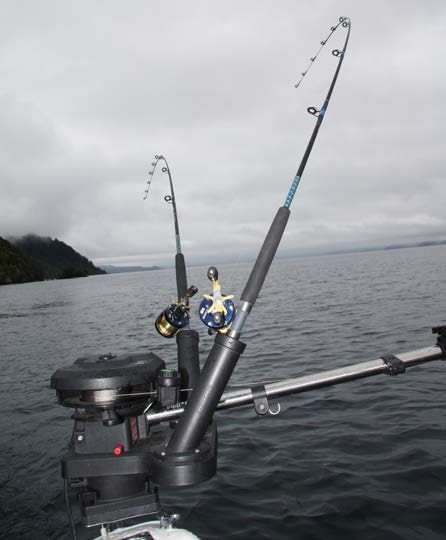
2) With a bit of practice, several lines can be ‘stacked’ off the one downrigger.

3) Depending on what is being targeted, there are different release clips available. The two clips on the left are for bigger game, the centre clip is for securing a stacker release to the cable and the two on the right are for trout trolling.
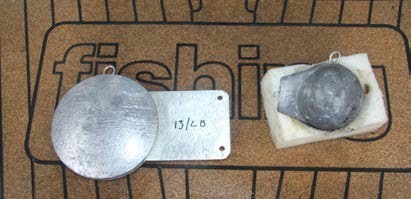
4) couple of downrigger ball options. They are available in a variety of weights and shapes.

1
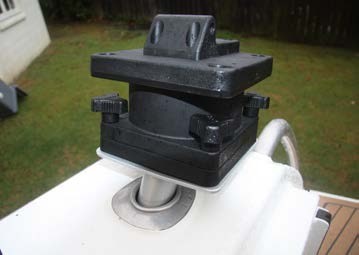
2
1 & 2) The writer’s ‘transportable’ custom downrigger base. Scotty now have an off-the-shelf version which is more adjustable.
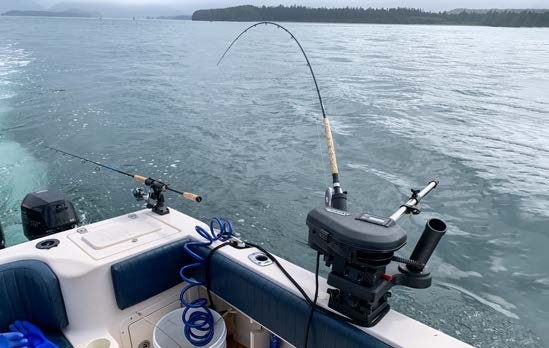
3) When trolling for trout, different set-ups can be used to fish different depths. The flatline out is running a lure just under the surface while the downrigger rod was set at 40 metres.
Another downrigger adaptation is to use it to run a dredge, another newish tool at Kiwi gamefishers’ disposal to enhance a billfish lure spread. I haven’t done this myself but I saw a trailerboat a couple of seasons ago run a dredge where the downrigger cable went to a pulley attached a few metres up the outrigger then back to a dredge. When they had a bite it would have been a simple matter to hit the up button which would bring the dredge up automatically, freeing up an extra pair of hands to clear gear.
The Scotty downriggers have an extendable arm which, if a dredge was run directly from the end, would offer enough reach to run it in the clear water. I would be inclined to run a support rope from the end of the downrigger arm to a point forward to help take some of the strain a dredge places off the arm and base. I intend to try it on Tackle Tester this coming season, using as light a dredge and weight as possible to reduce drag pressure.
Another adaption that adds to a downrigger’s versatility is to have it mounted on a removable rod holder base. Extreme Boats made a couple of these up for me which allows the ‘riggers to be swapped from boat to boat as the need arises. The same concept is available as a Scotty accessory.
“ DOWNRIGGERS ARE ONE OF THE MOST VERSATILE BUT UNDERUTILISED BITS OF KIT AVAILABLE TO RECREATIONAL FISHERS. ”
The one small hiccup is that not all rod holders are at the same angle and it means the ‘rigger doesn’t always sit 100% horizontally. It might not be pleasing to the eye, but it is still functional and is normally just a few degrees away from level. The downrigger and the base can be picked up and moved off the gunwale when gamefishing to free up cockpit space and allow the angler and wireman to do their thing unimpeded. Portability is enhanced by adding alligator clips as opposed to a plug at the end of the power cord.
If you are lucky enough to have a new boat in build, ask the manufacturer to beef up the gunwale if you plan to mount the downrigger in a conventional manner. In previous NZ Fishing News project builds we have had an extra plate welded on top of the gunwale to spread the load a downrigger can impart. When trolling at trout speed (1.8-2.3kn) this is not an issue, but start running a little faster with tuna and billfish in mind the additional support stiffens up the base.
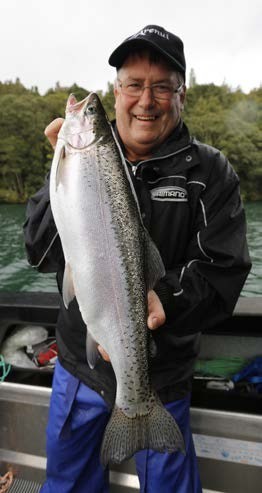
The writer with a prime Tarawera rainbow caught at harling depth on downrigging gear.